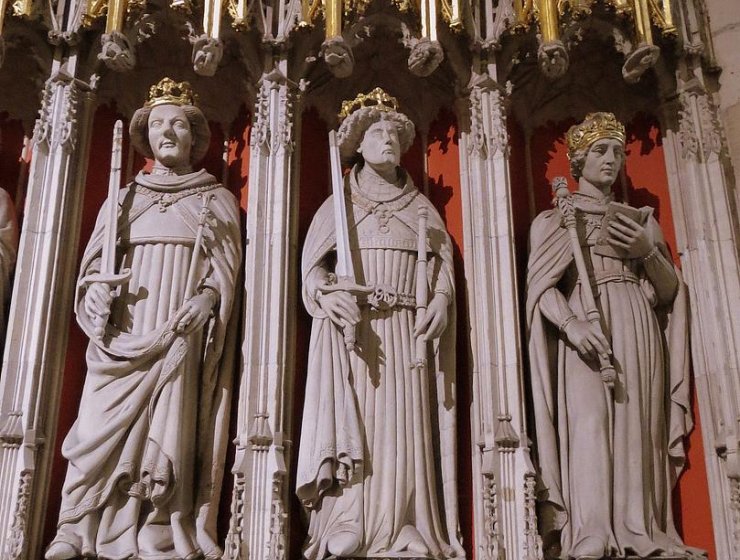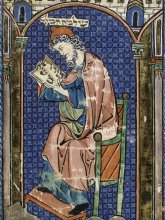
-Index-
Preface
Idea and image of royal power of the monarchies in Ancient and Medieval World
José María SALVADOR GONZÁLEZ
Special Issue
Art and History: the genesis of the monarchy conception in the Christian West (IV-VI centuries)
Ricardo da COSTA
Original title: Arte e História: a gênese da concepção monárquica no Ocidente cristão (sécs. IV-VI)
Keywords: Christianity, Clovis I, Constantine, Middle Ages, Monarchy, Theodosius I, the Great.
The article examines the birth of the Monarchy in the Medieval West. To do it, three paradigmatic cases that helped to build the monarchical ideal are analyzed: the conversions to Christianity of Constantine the Great (272-337) and King Clovis I (c. 466-511), beyond the submission of Theodosius I (347-395) to the Roman Catholic Church, with their corresponding images (fresco, painting, sculpture, coin, illumination, tomb).
The Golden Age of Islam: The Abbasid Caliphate Patronage and the House of Wisdom
Carmen Lícia PALAZZO
Original title: A Idade de Ouro do Islã: o mecenato do Califado Abássida e a Casa da Sabedoria
Keywords: Abbasid Caliphate, Baghdad, Golden Age, Islam.
This article analyses some aspects of the so-called Golden age os Islam by following the works of the Abbasid Caliphate, concentrating on the period ranging from the establishment of the capital at Baghdad up to 833, year of Al-Mamun’s death. The House of Wisdom (Bayt al-Hikma) is the most potent image among manifold activities, the memory of which lives on the present day. It bears witness to a period in the History of Islam during Which caliphal power acted as a patron to sciences, philosophy, arts, and literature.
«Caput et membras». The image of the Castilian king in the rhetoric and iconography
Osvaldo Víctor PEREYRA
Original title: «Caput et membras». La imagen del rey castellano en la retórica y la iconografía
Keywords: Body, Head, King, Member, image.
The construction of the archetypal image of the Castilian king implies the combination of a set of symbols of royal power during the Middle Ages are being incorporated place as their own manifestations of political-social gravity is reaching the monarchy front of the set of groups and classes privileged kingdom. This paper attempts to highlight some of these elements that involve the symbolic realization of the king's image both in the discursive construction and iconography that accompanies it.
Articles
The spirit, the groove of the self in St. Augustine
Giannina BURLANDO
Original title: El espíritu, surco del Yo en san Agustín
Keywords: Augustine, Inside of a man, Self, Spirit.
In Aristotle’s Greek ancient universe it is “a special set of material substances: the ether, the pneuma and the beginning of the transparency and the light, hot or brilliant all of them, all assets and they are not submitted to the qualitative change, which function consists of acting as vehicles and intermediaries across which the immaterial thing relates with all other material things and acts on them. Thereby, the immobile engine acts on the totality of the things by means of the fact of putting in movement the skies consisted of ether, and the soul acts on the body and reports with it by means of the pneuma.” Armstrong noticed that this idea has a great historical importance: it comes from the pre-Socratic thought and constitutes the immediate source of the stoic doctrine of the pneuma, which is one of the essential sources wherefrom there come the ideas of the fire or of the light as the material formative and active principle that we find then in Plotinus, and that for his influence, it will persist in the medieval philosophy. In this occasion we are interested in emphasizing how this current generated in the Greek world will persist in San Augustine's philosophy, although with a difference of emphasis, namely, the way of the self and subjectivity.
The pneumatology of Great Basilius in his treatise to Amphilochius Iconium
Eirini ARTEMI
Keywords: Amphilochius of Iconium, Arian controversy, Basilius of Caesarea, Holy Spirit, Homoousios, Pneumatology, Trinitarian teaching.
St. Basilius’ contribution to pneumatology is best comprehended within the historical milieu of the Arian controversy that pervaded much of the fourth century Roman Empire religiously and politically. It is a study which focuses on Basilius's understanding of the role and the Person of the Holy Spirit, particularly as found in his treatise to Amphilochius Iconium. The distinctive character of the Holy Spirit can be defined in the light of the Trinitarian relationship of the Spirit. Basilius, like Athanasius, defines the distinctiveness of the Holy Spirit in terms of His relation to God the Father and the Son. The status and position in their relationship defines the distinctiveness of each member of the Trinity. The definition of this kind occupies the major part of Basilius’ treatise of pneumatology. Basilius’ pneumatology cannot be understood; however, apart from his thoughts on salvation and baptism, which themselves are bound together. Basilius’ argument for the divinity of the Holy Spirit works by illustrating what the Holy Spirit does. The Holy Spirit illumines and sanctifies the baptized. The Holy Spirit completes and perfects creation from the beginning of time to its end and illumines the mind of the believer to understand the message of its order. The Holy Spirit inspires the Scriptures and governs their understanding in the church. Making no claim to know the essence of God, Basilius also leaves no doubt that the Holy Spirit has revealed his divinity through his actions. Only God does what only God can do.
Fleeing from the profane society: on the obstacles for the construction of authority, rule and the support of the church in the Passio sancti Venceslavi martyris
Andrea Vanina NEYRA
Original title: Huir de la sociedad profana: sobre los obstáculos en la construcción de la autoridad, el gobierno y el fomento de la Iglesia en la Passio sancti Venceslavi martyris
Keywords: Authority, Church, Obstacles, Wenceslas.
Bishop Gumpold of Mantua’s Passio sancti Venceslavi martyris, commissioned by King Otto II, depicts Wenceslas as a Christian ruler who brought together Christian virtues, ascetic practices along with active political power. This paper outlines the manifest opposition between those features and the characteristics attributed to the people subject to the přemyslid duke’s authority. The population was described as a society of savage people, tied to pagan error and heresy, who imposed significant barriers to the expansion of Christ’s faith in the region of Bohemia. Their incivility, lack of culture and infidelitas are all apparent through the use of certain attributes used to describe the population, its customs and beliefs: impious, delusional, profane, arrogant, inhuman. Thereby, the specificities defining the Bohemian society at the end of the 10th century coincide with Wenceslas’ most important opponent, his brother and fratricide Boleslav. The depiction of the savage, profane and illicit environment is a prefiguration of the final episode of the hagiographical text: the scandalous martyrdom of the future Bohemian patron saint. Similarly, the predestined Christian future of the Kingdom is prefigured in the hero’s early life –a Christian among an erring surrounding– as well as in his miracles.
About he name of St. Mary of Blaquerna: some questions and answers
Júlia BUTINYÀ
Original title: Sobre el nom de santa Maria de Blaquerna: algunes preguntes i respostes
Keywords: Crown of Aragon, Mariology, Middle Ages, Ramon Llull.
About the name of the Virgin who is identified with the protagonist of the first novel of Ramon Llull, Romanç d’Evast e Blaquerna, several contributions have been made lately; here we add some new and formulate some questions. Because to the hypothesis established about the image as coming from the church of the palace of Constantinople, I added that of Corfu as its original place. Now, the fact of having found two churches with the same name in the area of the Ionian Sea enhances the value and influence of the primitive image, as well as its original location in Corfu.























































































